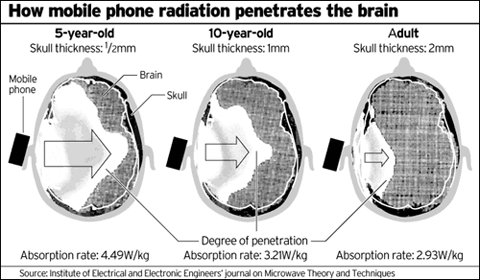
Choosing when a child gets a Smartphone is very important – a more important decision than many parents treat it.
ANNAPOLIS, Md. – Parents are advised to limit the time children spend on cellphones because radiation could affect a developing brain. (nih.gov) VERONICA CARTER, PUBLIC NEWS SERVICE – MD
Evidence is growing that cellphones may not be as safe as many people think they are.
Earlier this year, a study by the National Toxicology Program found exposure to wireless radiation significantly increased the prevalence of highly malignant heart and brain cancers in rodents.
CTIA, the wireless industry association, has said it’s reviewing the study, but that previous studies showed no established health effects from radio frequency signals used in cellphones.
Holiday 2016 Warning: Don’t Gift Wrap Brain Cancer! Smartphones, Kids and Cancer
Regardless, the American Academy of Pediatrics (AAP) this fall issued new recommendations for parents.
Ronald Melnick, formerly with the National Toxicology Program and now a scientific adviser for the Environmental Health Trust, says cellphones emit radiation, and the more people keep them off the body, the safer they will be, especially children.
“The penetration of the cellphone radiation into the brain of a child is deeper and greater,” he points out. “Also, the developing nervous system of a child is potentially more susceptible to a damaging agent.”

The American Academy of Pediatrics recommends that Smartphone use by children should be limited, and children should text more than talk when they do need a Smartphone. If they do call, children are advised to keep the device an inch or more away from their heads.
Everyone is advised to avoid carrying phones against the body, such as in a pocket, sock or bra.
Melnick says cell phone manufacturers can’t guarantee that the amount of radiation people absorb will be at a safe level.
Maryland resident Theodora Scarato is director of Public Policy and Educational Affairs at the Environmental Health Trust. She’s also a mother and says she used to believe that what you buy from the store is safe and that it’s been tested for safety. But she now says that’s not the case.
“If it were a drug it would be banned, or at least there would be a list of ‘These side effects have been reported,’ or at least ‘We don’t really know what the long term affect is,’” she states. “But we’re not really given any information and little babies are given these phones.”
Scarato says it’s hard as a parent to tell your children they can’t have a cellphone, or to strictly limit the use of other electronics, but her family has done that.
“It has not been easy making some of the changes we’ve made,” she admits. “But once we’ve done it we’re doing fine!
“And I’m actually really thankful that we don’t have devices beeping and interrupting things all the time. Because there’s nothing more important than my children’s health.”
Smartphones Do Cause Cancer – U.S. Government Expected To Advise Public of Health Risk
On 09/26/2016 the Environmental Health Trust issued a press-release titled, American Academy of Pediatrics Issues New Recommendations to “Reduce Exposure to Cell Phones” stating the following.
In response to the U.S. National Toxicology Program study results finding exposure to wireless radiation significantly increased the prevalence of highly malignant heart and brain cancers in rodents, the American Academy of Pediatrics (AAP) has issued specific recommendations to reduce wireless cell phone exposure and updated their online resources for parents concerning cell phones and wireless devices.
“They’re not toys. They have radiation that is emitted from them and the more we can keep it off the body and use (the phone) in other ways, it will be safer,” said Jennifer A. Lowry, M.D., FAACT, FAAP, chair of the AAP Council on Environmental Health Executive Committee in the AAPs press release on the NTP Study Results.
“The findings of brain tumors (gliomas) and malignant schwann cell tumors of the heart in the NTP study, as well as DNA damage in brain cells, present a major public health concern because these occurred in the same types of cells that have been reported to develop into tumors in epidemiological studies of adult cell phone users,” stated Ronald L. Melnick, PhD, the National Institutes of Health toxicologist who lead the NTP study design and senior advisor to the Environmental Health Trust. “For children the cancer risks may be greater than that for adults because of greater penetration and absorption of cell phone radiation in the brains of children and because the developing nervous system of children is more susceptible to tissue-damaging agents. Based on this new information, regulatory agencies need to make strong recommendations for consumers to take precautionary measures and avoid close contact with their cell phones, and especially limit or avoid use of cell phones by children.”
The AAP has updated their Healthy Children Webpage on Cell Phones entitled Cell Phone Radiation & Children’s Health: What Parents Need to Know. The webpage reiterated children’s unique vulnerability to cell phone radiation stating, “Another problem is that the cell phone radiation test used by the FCC is based on the devices’ possible effect on large adults—not children. Children’s skulls are thinner and can absorb more radiation.”
The AAP issued the following cell phone safety tips specifically to reduce exposure to wireless radiation:
Use text messaging when possible, and use cell phones in speaker mode or with the use of hands-free kits.
When talking on the cell phone, try holding it an inch or more away from your head.
Make only short or essential calls on cell phones.
Avoid carrying your phone against the body like in a pocket, sock, or bra. Cell phone manufacturers can’t guarantee that the amount of radiation you’re absorbing will be at a safe level.
Do not talk on the phone or text while driving. This increases the risk of automobile crashes.
Exercise caution when using a phone or texting while walking or performing other activities. “Distracted walking” injuries are also on the rise.
If you plan to watch a movie on your device, download it first, then switch to airplane mode while you watch in order to avoid unnecessary radiation exposure.
Keep an eye on your signal strength (i.e. how many bars you have). The weaker your cell signal, the harder your phone has to work and the more radiation it gives off. It’s better to wait until you have a stronger signal before using your device.
Avoid making calls in cars, elevators, trains, and buses. The cell phone works harder to get a signal through metal, so the power level increases.
Remember that cell phones are not toys or teething items.
“Even though the cell phone manual contains specific instructions that say do not carry the phone next to the body, the US government does not publicize this information nor mandate companies inform the public, leaving most people unaware of potential hazards, unwittingly allowing their young children to play with them like toys,” stated Devra Davis MPH, PhD, president of the Environmental Health Trust pointing to the Berkeley Cell Phone Right To Know Ordinance being challenged in court this month.
In 2012, the AAP published Pediatric Environmental Health, 3rd Edition recommending, “exposures can be reduced by encouraging children to use text messaging when possible, make only short and essential calls on cellular phones, use hands free kits and wired headsets and maintain the cellular phone an inch or more away from the head.”
Since 2012, the AAP has supported the Federal Cell Phone Right to Know Legislation and has written letters to the FCC calling on the federal government to review and strengthen radiation standards for wireless devices in an effort to protect children’s health.
Links
AAP Healthy Children.org Cell Phone Radiation & Children’s Health: What Parents Need to Know
https://www.healthychildren.org/English/safety-prevention/all-around/Pages/Cell-Phone-Radiation-Childrens-Health.aspx
AAP Pediatric Environmental Health, 3rd Edition
AAP responds to study showing link between cell phone radiation, tumors in rats May 27, 2016
http://www.aappublications.org/news/2016/05/27/Cancer052716
2012 AAP Letter in Support of the Cell Phone Right to Know Act
http://ehtrust.org/wp-content/uploads/2015/12/aap_support_letter_cell_phone_right_to_know_act.pdf
2013 AAP Letter to the FCC calling for a review of RF guidelines
https://ecfsapi.fcc.gov/file/7520941318.pdf